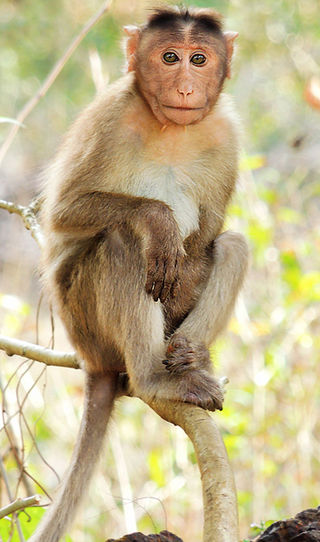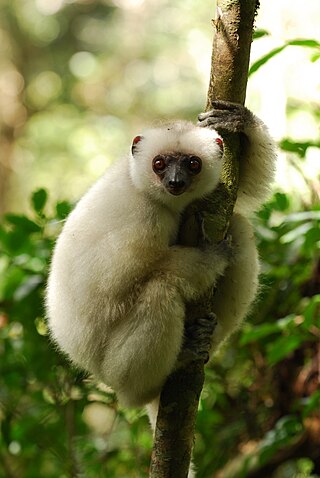
The International Union for Conservation of Nature (IUCN) Red List of Threatened Species, also known as the IUCN Red List or Red Data Book, founded in 1964, is an inventory of the global conservation status and extinction risk of biological species. A series of Regional Red Lists, which assess the risk of extinction to species within a political management unit, are also produced by countries and organizations.

The macaques constitute a genus (Macaca) of gregarious Old World monkeys of the subfamily Cercopithecinae. The 23 species of macaques inhabit ranges throughout Asia, North Africa, and Europe. Macaques are principally frugivorous, although their diet also includes seeds, leaves, flowers, and tree bark. Some species such as the long-tailed macaque will supplement their diets with small amounts of meat from shellfish, insects, and small mammals. On average, a southern pig-tailed macaque in Malaysia eats about 70 large rats each year. All macaque social groups are arranged around dominant matriarchs.

The guenons are Old World monkeys of the genus Cercopithecus. Not all members of this genus have the word "guenon" in their common names; also, because of changes in scientific classification, some monkeys in other genera may have common names that include the word "guenon". Nonetheless, the use of the term guenon for monkeys of this genus is widely accepted.

A least-concern species is a species that has been evaluated and categorized by the International Union for Conservation of Nature (IUCN) as not being a focus of wildlife conservation because the specific species is still plentiful in the wild. They do not qualify as threatened, near threatened, or conservation dependent.

An IUCN Red List Critically Endangered species is one that has been categorized by the International Union for Conservation of Nature as facing an extremely high risk of extinction in the wild. As of December 2023, of the 157,190 species currently on the IUCN Red List, 9,760 of those are listed as Critically Endangered, with 1,302 being possibly extinct and 67 possibly extinct in the wild.

The Japanese stream toad, also known as the Honshū toad, is a species of toad in the family Bufonidae. It was first described by Masafumi Matsui in 1976 during research with Kyoto University as a "moderate to large-sized toad" with a "peculiar color pattern" and "stream-dwelling habits."
The El Pepino tree frog is a species of frog in the family Hylidae found in Colombia and Ecuador. Its natural habitats are subtropical or tropical moist lowland forests, subtropical or tropical moist montane forests, rivers, and swamps. It is threatened by habitat loss.
Pristimantis torrenticola is a species of frog in the family Strabomantidae. It is endemic to Colombia. Its natural habitats are tropical moist montane forests and rivers. It is threatened by habitat loss.

Phacochoerus is a genus in the family Suidae, commonly known as warthogs. They are pigs who live in open and semi-open habitats, even in quite arid regions, in sub-Saharan Africa. The two species were formerly considered conspecific under the scientific name Phacochoerus aethiopicus, but today this is limited to the desert warthog, while the best-known and most widespread species, the common warthog, is Phacochoerus africanus.

Orthochromis is a genus of relatively small haplochromine cichlids native to rivers and lakes in Eastern and Middle Africa. Most of its species are rheophilic.
Gradsteinia is a genus of moss in family Amblystegiaceae.
Harttia torrenticola is a species of armored catfish endemic to Brazil where it is found in the São Francisco River basin. This species grows to a length of 7.7 centimetres (3.0 in) SL.

The World's 25 Most Endangered Primates is a list of highly endangered primate species selected and published by the International Union for Conservation of Nature (IUCN) Species Survival Commission (SSC) Primate Specialist Group (PSG), the International Primatological Society (IPS), Global Wildlife Conservation (GWC), and Bristol Zoological Society (BZS). The IUCN/SSC PSG worked with Conservation International (CI) to start the list in 2000, but in 2002, during the 19th Congress of the International Primatological Society, primatologists reviewed and debated the list, resulting in the 2002–2004 revision and the endorsement of the IPS. The publication was a joint project between the three conservation organizations until the 2012–2014 list when BZS was added as a publisher. The 2018–2020 list was the first time Conservation International was not among the publishers, replaced instead by GWC. The list has been revised every two years following the biannual Congress of the IPS. Starting with the 2004–2006 report, the title changed to "Primates in Peril: The World's 25 Most Endangered Primates". That same year, the list began to provide information about each species, including their conservation status and the threats they face in the wild. The species text is written in collaboration with experts from the field, with 60 people contributing to the 2006–2008 report and 85 people contributing to the 2008–2010 report. The 2004–2006 and 2006–2008 reports were published in the IUCN/SSC PSG journal Primate Conservation,, since then they have been published as independent publications.
Orthochromis torrenticola is a species of cichlid endemic to the Democratic Republic of the Congo, where it is known from the Lufira drainage in the upper Congo River basin. This species can reach a length of 8.1 centimetres (3.2 in) SL.
Torrenticolidae is a family of torrent mites in the order Trombidiformes. There are about 5 genera and at least 20 described species in Torrenticolidae.
Oreoleptidae is a family of flies. The family was established in 2005 on the basis of the type species Oreoleptis torrenticola placed in the monotypic genus Oreoleptis. The only known species was collected from the Rocky Mountains where the larvae grow in torrential streams. Larvae have also been found in groundwater wells. The larvae are similar to those of Athericidae and Tabanidae but with long crocheted false-legs (prolegs) arising from abdominal segments 2-7. The larvae have hollow mandibular hooks.
Torrenticola is a genus of arachnids belonging to the family Torrenticolidae.
Leporinus torrenticola is a species of anostomid fish. It is endemic to Brazil and found in the middle Xingu River and its two major tributaries, the Iriri and the Curuá, in Pará state.









